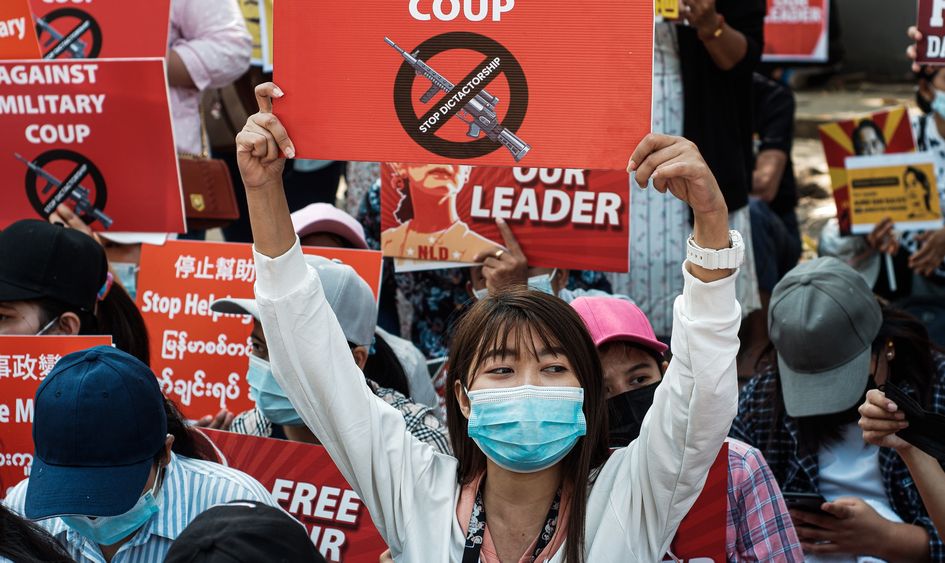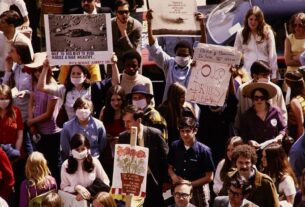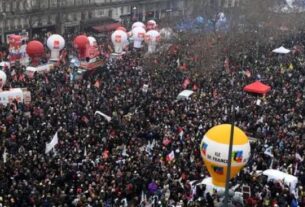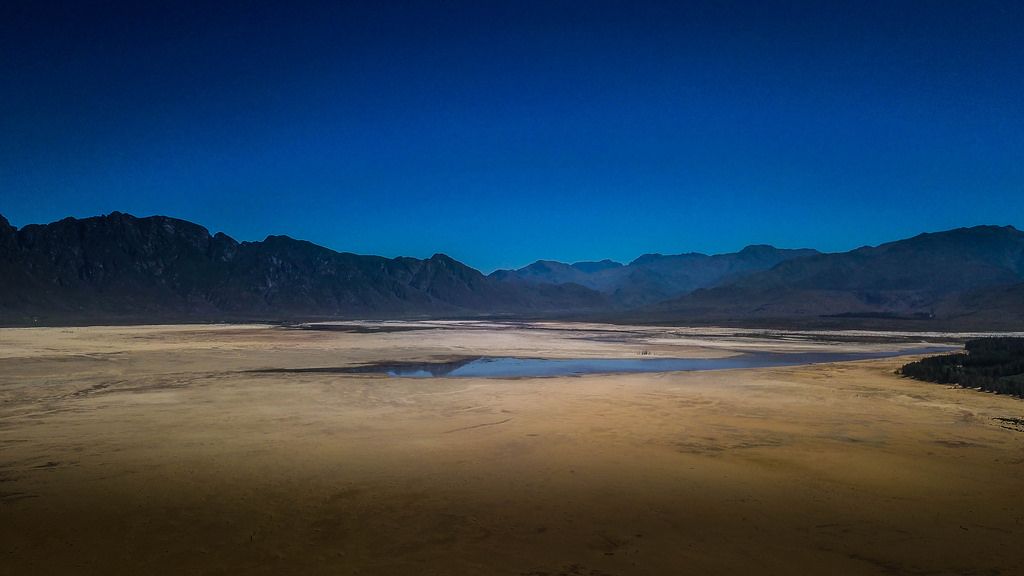Geert Cool is a member of Linkse Socialistiche Partij / Parti Socialiste de Lutte (ISA in Belgium).
General strikes show potential to defeat coup. Mass movement must start organising society
More than a month after the military coup led by Min Aung Hlaing, the struggle between the people and the military of Myanmar continues. Strikes paralyse daily life. The general strikes on 22 February and 8 March were highlights of the movement so far. The army, the Tatmadaw, reacted after 22 February with even more violence, which left many dead.
The best known victim of this deadly repression has been 19-year-old Angel Kyal Sin. She was killed on 3 March in Mandalay, the country’s second largest city, while wearing a t-shirt with the slogan: “Everything will be OK.” There were 38 deaths on March 3, making it the bloodiest day so far. The first fatality was 20-year-old student Mya Thwate Khaing, who was shot on 9 February and died ten days later.
These martyrs of the movement are young women, as are many of the movement’s leaders. The working class occupies a central position: the strike has been the movement’s main weapon and once again proves to be particularly effective. Among the first groups to go on strike were workers from sectors that had already been involved in strike in recent years. Health workers were at the forefront after a year of health crisis. Teachers and young people had taken action in 2014–15 against an education reform, creating a stronger education union. Workers in the fast-growing textile sector, which now accounts for up to 900,000 workers, most of them women, already went on strike in 2019 for better working conditions. The global pandemic and falling demand for textiles by major clothing brands led to layoffs and new protests more recently.
The general strikes show the potential to defeat the coup. When the working people shut everything down, the army command has nowhere to go. To really drive them from power, the movement itself must start organising society on the basis of the interests and involvement of the majority of the population. A victory for this revolutionary movement would have international consequences. Just as this movement has seen the ‘Hunger Games’ three-finger salute spread internationally, the example of strong and victorious strike movements can spread from Myanmar throughout the region and beyond.
General Strikes
In the run-up to the general strike of 22 February, there were several protest actions to disrupt daily life. On 17 February, for example, people faked car breakdowns, bringing all traffic in major cities such as Yangon to a standstill. In the villages, tree trunks were laid across the roads to prevent army vehicles from entering.
In the first phase of the protest against the military coup of 1 February, health and education workers took the lead. They went on strike and this example was soon followed in many other sectors.
There is no long tradition of trade unions in Myanmar. Trade unions were re-established in the 1988 movement against the military junta and have only been functioning legally since 2011. The General Confederation of Trade Unions had only 65,000 members in 2018 out of a population of 54 million. There are some particularly militant unions that have grown on the basis of workers’ action. This is the case, for example, in the garment sector, which has grown particularly rapidly in recent years, and in which workers have begun to demand their share of the cake. In 2019, there was a wave of strikes for wage increases and better working conditions. This was followed in 2020 by strikes against arbitrary dismissals, targeting union members, and for safe working conditions during the health crisis. Throughout the current protest against the coup, trade unions are growing and new ones are emerging.
On 22 February, millions of people went on strike. Not only in sectors where strikes were already taking place, but in all parts of the economy. From mines and factories to restaurants and informal street vendors. Everything went down and it stayed down all day. Hundreds of thousands of people took to the streets in all the cities and in the countryside. This general strike was called the “22222 revolution”, after the five twos that appear in the date 22 February 2021. The news site Irrawaddy.com reported that in Mandalay, the country’s second largest city, it seemed that literally every inhabitant took to the streets in a demonstration which, according to veterans of the 1988 protest movement, was even bigger than this historic mobilisation. Even in Naypyidaw, a city that was artificially built between 2002 and 2012 to serve as a “safe” capital for the regime, there were strikes and demonstrations.
A strike that is so generalised brings the entire country to a standstill. This has consequences. Actions taken by bank staff made it impossible for the coup leaders to pay military wages, while they desperately need the support of rank and file soldiers to hold on to power. Hundreds of employees of private and public banks joined trade unions and joined the Civil Disobedience Movement (CDM). Because of the strike, companies and the government have hardly any access to money. It is somewhat reminiscent of the reactionary Kapp-putsch in Germany in 1920, when the right-wing coup plotters could not find a printing plant which was not on strike, and therefore could not get the official announcements of the coup printed.
This does not mean, of course, that this is “game over.” The intensification of repression by the army leadership is an expression of desperation, which can be extremely dangerous. The new general strike on 8 March confirmed the potential of the movement and the failure of repression. If two general strikes are not enough to topple the regime, a general strike of indefinite duration must be called. In a number of sectors, workers have already been on strike since early February.
Civil Disobedience Movement
The Civil Disobedience Movement plays an important role in the movement, pushing it forward from below against the military dictators. This is a remarkable feature of the situation. Previously, Aung San Suu Kyi’s National League for Democracy (NLD) was generally seen as the central organisation of the opposition to the military. However, its participation in government in recent years and cooperation with the army undermined the NLD’s authority. The protest movement was launched by health workers, teachers and other workers. They launched the Civil Disobedience Movement as a Facebook page, with over 300,000 followers.
Health workers occupy a special place after a global health crisis that also struck Myanmar. Moreover, there is some trade union organisation in the sector. In the education sector, there is a relatively strong trade union, the Myanmar Teachers’ Federation, which now claims to have 100,000 members. The scale of the protest movement has even led a number of employers and international companies to end their cooperation with the government. It is also the pressure of the movement and the isolation of the coup regime in Myanmar that has prompted international leaders like Biden to make statements against the military and impose sanctions.
The power of strikes is important, but at the same time it must be harnessed by the organisation of strike committees and regional action committees. In the 1988 movement, strikers’ committees and people’s committees played an important role. Such bodies are also needed now. They were important then to ensure that the protest movement was not hijacked by old “crocodiles.” Now that the majority of the population in Myanmar is looking how to get completely rid of the military regime, it will be necessary for the movement to set up and control its own organisations and instruments of struggle. The General Strike Committee which was set up for the 22 February strike was a promising start. However, it would be better to set up the General Strike Committee based on local committees in the workplaces and in the neighbourhoods which coordinate on a national level, rather than start from the other way around.
Lessons from History — Program for Real Change Needed
Despite the existence of illusions in concepts like ‘leaderless’ movements, there is always a tendency for a leadership vacuum to be filled. If the workers and poor peasants do not fill it from below, there will always be candidates to swoop in from above. In the 1988 movement, former Prime Minister U Nu tried this, but his attempt was thwarted by the rapid development of a new political party from within the movement: the National League for Democracy (NLD). That party looked to Aung San Suu Kyi, the then recently returned daughter of a former freedom fighter, as its new leader.
Today, Aung San Suu Kyi is in a similar position to U Nu in 1988. Her NLD did not play a central role in organising the protest and the regime it was part of has clearly failed. Nevertheless, the lack of a political expression of the mass movement and the authority it acquired through repression has enabled the NLD to regain its footing. On 2 March, a committee of NLD MPs set up the Cabinet of Committee Representing Pyidaungsu Hluttaw (CRPH, Pyidaungsu Hluttaw is the name of the parliament). This is an alternative government with four ministers: three NLD politicians and an independent academic, Dr Zaw Wai Soe, who is the rector of the medical university who played a central role in the fight against Covid-19 in Yangon. He immediately called on all civil servants to join the Civil Disobedience Movement (CDM). The CDM explicitly calls for the recognition of the CRPH, thus actually handing the initiative back to the NLD.
It is normal that there are illusions among the population in the CRPH and the protests rightly call for the release of all political prisoners. However, the question is what policy the CRPH proposes, what tactics to use against the army and what alternative is to be put in place if the coup leaders are driven out. A return to the way things were before is not an adequate answer to the concerns of the population. Cooperation with the army, for example, will not be accepted.
To get rid of the army, the struggle must be fought on the political but also on the economical plain. The army tops played an active role in the privatisations which swept the economy after 1988. Many important companies are in military hands, including the Myanmar Economic Corporation (MEC) or Myanmar Economic Holding Ltd (MEHL), which bought up some lucrative parts of the economy in the privatisation wave. This is instinctively understood in the movement: for example, beer from Myanmar Beer or products from telecom operator MyTel (both part of MEC) are being massively boycotted.
The protest movement needs a program to really give power to the people. This means not only democratic elections, but control by the people over the key sectors of the economy to enable democratic planning of the country’s vast wealth. This will not happen through the CRPH, even if this body, under pressure from the movement, has to adopt a more radical profile than what was previously advocated by the NLD. The policy of cooperation with the army has failed, so the NLD must turn its back on this. However, even that is not enough to bring about fundamental change.
International Reactions
There is an instinctive understanding in the movement that solidarity is important both domestically and internationally. There is a healthy attitude towards the national question and the rights of the many minorities in the country. With English-language protest signs, the demonstrators explicitly call for international solidarity. They are not so much aiming at the international institutions and leaders, but at the ordinary people with a special attention for earlier movements in Thailand and Hong Kong. Here and there, there are illusions about the role of the US, but this currently seems rather marginal within the movement.
The international capitalist leaders never showed any interest in the majority of the population in Myanmar. When Aung San Suu Kyi was released and the NLD announced that it would participate in by-elections for 45 seats in 2012, the international establishment poured into Myanmar in the hope of snatching up lucrative business deals. That there was something to pick up had already become clear after the privatisations and the opening up of the economy after 1988: for example, Total, Chevron and the Thai PTT stepped into the oil and gas company Myanma Oil and Gas Enterprise.
Political leaders such as Hillary Clinton nearly fell over each other’s feet to be the first to have tea with Aung San Suu Kyi when she took up governmental responsibilities. The Wall Street Journal noted at the time: “Myanmar’s potential is too great for some investors to ignore. One of the last, large frontier markets in Asia, it is rich in oil, gas, timber and gems and has the potential to be a major rice and seafood exporter.” (‘Firms See Myanmar as Next Frontier’, WSJ 30 November 2011).
Moreover, the US and Europe wanted to limit China’s influence. In 2010, there were already 12.3 billion dollars worth of Chinese investments in the country. The Chinese regime hopes to gain access to the Indian Ocean through Myanmar, important for the Belt and Road Initiative. Today, the military leadership — the same that in the 1960s started a dictatorial regime modelled on Mao’s China — is desperately trying to maintain Chinese support for the coup. The Chinese regime refuses to condemn the coup and speaks of a “reshuffling of the cabinet.” Yet the Chinese ambassador to Myanmar, Chen Hai, had to acknowledge that the current situation is “absolutely not what China wants to see.”
No doubt that by this, Chen Hai means the Chinese regime would prefer not to see mass protests in the region. The foreign minister of Singapore, a key trading partner of Myanmar, said he hopes the Asian bloc ASEAN can play a “discreetly constructive role” to facilitate Myanmar’s “return to normality and stability.” Indian Prime Minister Modi, who has had good ties with army chief Min Aung Hlaing in the past, is keeping a low profile as far as possible on the events in India’s eastern neighbour.
The imperialist and regional powers may have different attitudes towards the military coup plotters, but they have in common that they would like to see the end of the mass movement as soon as possible.
What is Now to be Done?
The current movement shows the power of the working class, even in a country where the majority of the population is engaged in agriculture. The working class in action is playing the leading role, drawing the rural population behind it in support. They are mainly demonstrating for democratic demands and against the military dictatorship, but it is clear that every democratic demand soon takes on a social character. Breaking the power of the military leadership inevitably also means breaking its economic position and questioning the entire system.
Opening the economy to private initiative and foreign companies from 1988 on did not mean social progress for the majority of the population. The entire system must be challenged. Only a socialist transformation of society can give real substance to the movement’s demands. To this end, the key sectors of the economy, including natural resources, must be nationalised. Not nationalisations such as those that took place after 1963, controlled by a small clique at the top, but nationalisation under the democratic control of the people.
To give direction to the movement, there must be discussion on what demands to put forward and an alternative to the current system, in which the army plays a central role. Strike committees and action committees in the workplaces, neighbourhoods and villages are necessary to democratically discuss the next steps of the protest and to organise them with the greatest possible involvement. Such committees are also necessary to organise self defence against repression. These committees should coordinate at a local and national level, while also taking charge of managing key aspects of the daily life of workers and poor people such as the distribution of food, medical care and other urgent needs. A clear program and leadership for the movement would attract rank and file police officers and soldiers to the side of the people. These democratic organs of the movement could lay the foundation for a different type of society. A Constituent Assembly elected by the working class, the rural population and the oppressed through such democratic structures could agree a plan to fundamentally change society.
The most urgent steps in this phase of the movement are its structuring and the discussion of demands and alternatives. Both elements go hand in hand: one the one hand, structuring the movement will inevitably lead to discussions about its content, and on the other hand, to change society it is necessary to develop levers to achieve this change. Revolutionaries, like the members of International Socialist Alternative, would of course play an active role in such a process, advocating socialist change. In a mass movement, a socialist program can quickly find a wide audience, but an organisation of revolutionaries is needed to develop it, refine it and introduce it in the movement so that it becomes a material factor.
The movement is stronger when it responds to every attempt to divide and rule with unified struggle. This means that attention to national demands and sensitivities is essential, especially in a country with over 135 ethnic groups. The military regime has a long tradition of violence against minorities, from the expulsion of hundreds of thousands of Tamils in the 1960s under Ne Win to the persecution of Rohinya Muslims in the north-west of the country that has been pushed to the extreme since 2015.
Aung San Suu Kyi’s NLD has been complicit in the oppression of minorities. The protest movement must counter this. Bringing together the workers and oppressed of the Bamar majority population with Shan, Karan, Rakhine, Chinese … makes the movement stronger. This unity requires respect and thus recognition of the right to self-determination. While we are not in favour of simply waving national or regional flags, it was in itself positive that during the general strike of 22 February, flags of different national minorities were explicitly carried by the activists. A program that recognises the right to self-determination can shape this instinctive feeling so that it becomes a powerful argument to further strengthen the movement among all ethnic groups.
These are some of the central elements of our socialist approach, which aims to overthrow capitalism and replace it with a socialist society with a democratically planned economy in which the country’s enormous wealth, and the enormous potential of its creative and young working class, can be used to the full for the benefit of the entire population. Such a step would immediately gain an enormous audience in the region and the rest of the world.
For more information: Facebook




